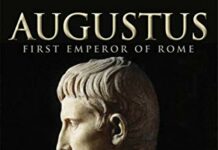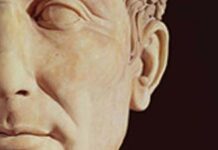
Ebook Info
- Published: 2012
- Number of pages: 420 pages
- Format: PDF
- File Size: 1.97 MB
- Authors: Adrian Keith Goldsworthy
Description
The struggle between Rome and Carthage in the Punic Wars was arguably the greatest and most desperate conflict of antiquity. The forces involved and the casualties suffered by both sides were far greater than in any wars fought before the modern era, while the eventual outcome had far-reaching consequences for the history of the Western World, namely the ascendancy of Rome. An epic of war and battle, this is also the story of famous generals and leaders: Hannibal, Fabius Maximus, Scipio Africanus, and his grandson Scipio Aemilianus, who would finally bring down the walls of Carthage.
User’s Reviews
Reviews from Amazon users which were colected at the time this book was published on the website:
⭐I think that Adrian Goldsworthy is the best popular historian on Rome working today. While he has a beautiful writing style, he also is thoroughly versed in the scholarly issues, which he brings into the discussion without the excesses of academic proofs and oneupmanship. It is a very difficult balance to strike and the author does it to perfection. This book is at the undergraduate level, for those seriously interested in the three Punic Wars. Rather than make comparisons with the present, the author’s purpose is to explain the wars in historical context, from a strictly military point of view; in this way, to his great credit, he refuses to make fatuous generalizations of relevance to the twit pundits who have way too much to say about things they know way too little about.The book starts off pretty dry, with a long discussion of the states of Carthage and Rome at the time that the conflict began. While I was very interested in the political systems of both states and the tidbits that Goldsworthy includes on their civilizations, his dissection of their military machines was a bit too much for me. The Romans relied primarily on a reservoir of manpower from farm owners in Italy, which included rather loyal Latin and Italian allies in addition to some Spanish mercenaries. They were driven largely by patriotism, were governed in accordance with the yearly elected consuls of the Republican system, and were essentially amateur soldiers. With their reservoir of human capital, their great advantage lay in the application of overwhelming brute force, which they applied until their adversaries were exhausted; the difference was that the Romans absolutely refused to stop or accept defeat. Politics was inextricably linked to military action, though the consuls were patrician aristocrats seeking glory for parochial political motives and hence also military amateurs. Up to this point, there was little refinement or subtlety to their tactics and diplomacy. That was about to change.In contrast, the Carthaginians had a dispersed empire that spanned the western Mediterranean in a C-shape, colonies that had long broken free from their origin in Phoenicia (i.e. semitic Lebanon). There was a core of Carthaginian aristocrats that controlled all of the myriad ethnic groups under their influence, mainly for purposes of trade – mostly maritime – and only secondarily for military use; they excelled at nuanced diplomacy and negotiation. In addition, there was a caste of professional military officers, who managed a huge mercenary army and various allies that operated in somewhat ethnically separate units (i.e. wings in am eclectic army, which fundamentally effected their cohesion). With their experience from an early age, the military leader caste operated more from intelligent tactics and highly developed specializations, in particular in naval maneuverability, the use of elephants to overawe their adversaries on land, and flexible military formations. The contrast with Rome could not be more stark.The first Punic War broke out over control of Sicily, which was a patchwork of Carthaginian, Greek, and Italianate city states. After many indecisive skirmishes, Rome sent troops – the first time they left the Italian peninsula! – and built its first navy. In time, after many disasters, some natural others due to lack of experience, the Roman navy beat Carthage by attrition as did the Roman Army. Carthage sued for peace, agreed to pay massive indemnities (which they did), and gave up Sicily and many other possessions for the promise of peace as subordinates. I have seen their colony off of Marsala and have been fascinated with their culture ever since. Carthage offered a very different possible future.Hannibal, of the Barca military clan, was assigned Spain, which he consolidated for Carthage to the growing disquiet of Rome. It was clear from the outset that he was an extraordinary military talent; though little is known about his character or psychology, his motivation, in Goldsworthy’s opinion, was to weaken Rome as a prelude to negotiation rather than destroy it, in the Carthaginian way. As tensions built, in 218 BCE – after more than 20 years of peace – at 26 years of age, Hannibal moved a massive army across the Alps into Italy, an unprecedentedly massive movement of troops in Europe, complete with elephants, and attacked Rome at its heart. He gathered many followers along the way (in a scale of tens of thousands, of SPaniards and Gauls, but, significantly, rarely of Latins or Italians) that he had to feed, arm, and inspire. This he did by winning early significant victories, ravaging the countryside, and stealing what he could while vainly attempting to recruit southern Italians.The Romans had never faced such a threat, from a strategist and leader of genius who adapted his tactics to their weaknesses, e.g. Cannae, where he enveloped and attacked from behind a massive Roman phalanx that could only march forward and hence unable to regroup and reform, resulting in a slaughter of nearly 50,000 Romans, or 1/10 of the entire potential military manpower in Italy. In all later military literature, Cannae became a touchstone noun. Against their military culture, the Romans voted in a dictator for 6 months, Fabius Maximus, who harassed but would not engage Hannibal in any decisive battles (named the Fabien strategy). It bought Rome time to regroup and attack in N. Africa, once again bringing its adversary down by superior force. Never defeated in Italy, Hannibal had been ordered to defend Carthage – his only failure – and was exiled soon after the defeat. His tactics, many of them perhaps apocryphal, inspired Romans to think the unthinkable for the remaining life of the Western Empire; Hannibal was the indispensable catalyst to Rome becoming a first-rate global power. Rome emerged with a far better trained army under its own military genius, Scipio. This was the true beginning of the Roman Empire. The third Punic War was shamefully manufactured by Rome and consisted of a siege of Carthage, which was completely destroyed in 146 BCE.The difference between the 2 Empires was that, contrary to the expectations of Carthage, Rome regarded the fight as one to the death: the Roman republicans refused all compromise and instead of giving up, resolved to fight on no matter what the sacrifice, even at the risk of total destruction. This explains why in the end, when they had the means in spite of Carthage’s behavior as a good subordinate, the Romans resolved to annihilate any rival power. Rome then went on to completely dominate the entire Mediterranean, the undisputed power of the ancient world for the next 600 years or so, in large part from what it learned from the conflict with Carthage. This is military history at its absolute best.Goldsworthy is very good at fleshing out, in a moderate way that does not imply a deterministic argument, the problems that the Roman Republic then faced; this includes a dwindling pool of military manpower as the smaller independent farms declined and slaves were imported to work massive latifundia, coupled with an excessively competitive political system that promoted sleazy maneuvering to gain power at the expense of the interest of the nation (e.g. Scipio, not a good politician, was forced out, chose exile, and died while relatively young, squandering a unique talent). This eventually culminated, with the Marian reforms, in the creation of a professional military, whose loyalties lay not with the Republic but with the generals to whom the proletariat grunts aligned themselves with “guarantors” of their security and life style, which the Republican Senate refused to grant for short-term political machinations. The refusal to consider the legitimacy of the demands of the Italian and Latin allies perhaps also rendered a “social war” inevitable.I do have criticisms of the book. I wanted much, much more on civilization and politics, particularly of the Phoenicians and what they built in Carthage. The details (predominantly) as included are also very spare, offering much less of a feeling for life at the time than I had expected after Goldsworthy’s absolute masterpiece bio of Caesar. I also would have wanted illustrations (there are none) and more detailed maps. Finally, there is not a good “further reading” section, for which any serious reader would hunger.This is absolutely essential stuff that any student of history or Rome buff must know. Hence, it is one of the basic reads that will stand as a classic in my opinion. I give it 4 syars only because of its occasional dryness as a reading experience.
⭐Good context for the academic and nonacademic Roman history researcher. Good to subsidize other histories, like ke the History of Rome podcast.
⭐This book was originally published under the title “The Punic Wars”, which I think better describes the book than the “Fall of Carthage” because the book is about all three of the Punic Wars. Most books on the Punic Wars deal only with the second one – the one with Hannibal and the elephants crossing the Alps. As the author points out, we know much more about the second war, so it is not surprising that this one gets much more attention. However, the first and third wars are important and should not be ignored. The first explains why the second occurred and the third finishes the story of the conflict. This book is very interesting and I learned a lot more than just about the battles of the Punic Wars. I learned about the Roman army of the period, about the Roman political system and politics of the time, and why these wars were fought and their consequences.The fact that this is a republication of a book is important, because this version has been shrunk down in physical size (but not page length). The original is, according to the Amazon description, 9.2×6.3 inches, whereas this book is only 7.7×5 inches. To achieve this smaller size, the size of the print has been reduced, as have the margins. The inner margin is only 3/8 inch from the spine of the book, compared to a more typical 5/8 inch. Why do I mention this? Well, the smaller print makes the book harder to read and more importantly I had to break the spine of the book to be able to see the material at the inner margin. Thus, it is doubtful that the book can stand up to a second reading. This is OK for a novel that one might throw away after reading, but it is not for a book that one might want to keep for reference.As noted in the title of this review, this is an academic treatment. Most non-academic treatments provide a straightforward narrative based on the author’s view of the history. Professor Goldsworthy presents all interpretations of the history. Thus, much of the book contains sentences of the sort – A believes …, whereas C believes…, and D believes…, and I believe that … is closest to the truth because… This approach interrupts the narrative, but it is a fairer approach in that it makes it clear that there is a great difference of opinion about many aspects of the Punic wars (as is the case for all of the history of antiquity). This is what I mean by the book being an academic treatment. Some readers will like this approach; others will feel that what they were expecting to be an exciting story of battles becomes dry history.Also as noted in the title of this review, this is a military history, as opposed to one that focuses on political, social, or religious aspects of the period being covered. This is not to say that these aspects are not considered, only that they are discussed in the context of the military conflict. (A great deal of information is provided about the political system and the politics of this period – information that is essential for understanding the military aspects of the war.) There are very good appendices that contains a description of the political system of the republic, the organization of a Roman Consular Army of the period, and a detailed chronology of events.While this is a military history it does not focus entirely on the fighting involved with the pivotal battles, such as Cannae. There is a 24-page chapter on Cannae, but it is devoted to much more than the battle itself. It covers the military and political events leading up to it and the extremely important consequences of the battle, but the battle itself is covered in only seven pages. There is one map that concerns Cannae, with a very small insert showing the initial disposition of forces. (There are a total of 16 clearly drawn maps in the book, but no photographs of ancient ruins, or artifacts. Likewise, there are also no drawings of soldiers in battle dress or alike.) You will learn much more that just about the fighting, but the treatment is less exciting that one that focuses on the battle itself.While the author makes pains to state that he is interested in the Punic Wars in their own right, as opposed to any contrast with modern conflicts, the last few pages of the book briefly compare these wars to WWI and WWII. The comparisons are striking, as are the lessons to be learned; pointing up the need to understand the lessons of history. I recommend this book to those who want to learn the lesson that these wars teach. However, it is not as exciting as some books about this period, but this in more than made up for with the wealth of information that is provided. I liked the honest admission of where the historical sources are lacking or contradictory. There is a clear analysis of the factors that brought on the wars, the factors that led to one side or the other being victorious in a given battle and why the Romans ultimately won, in spite of suffering horrendous losses.I would have given the book five stars were it not for its shrunk down size. I would have gladly paid a few dollars more to get a book that would last for a second or third reading.
⭐Knowing how amazing a writer Goldsworthy is about ancient subjects it is heartbreaking that there isn’t enough historical sources for the big man to sink his teeth into. There’s barely any for the first Punic war and it’s admirable that Goldsworthy wrote as much as he did with such flair. Hannibal? We know NOTHING about the bloke with the elephants personality. I suppose the Romans wanted to erase him and his legacy from the face of the earth and only wanted their side of the story told. Goldsworthy does an amazing job at highlighting Rome’s resilience in the wars and also their ruthlessness throughout the Carthage conflict, especially in the third war. If there were more sources this would easily be a 5/5
⭐This book, while perhaps not perfect and containing some questionable statements, is probably the best introduction, overview and starting point for someone wanting to get to grips with the Punic Wars. It is also an excellent introduction to Rome’s dominance of the Mediterranean and of Roman imperialism, more generally, with these elements, and the “Roman way” of waging war, being the author’s real speciality.Perhaps the main merit of this book is to clearly identify why Rome won the first two epic and lengthy wars according to Goldsworthy. As the author shows, Roman commanders and their legions and allies were not necessarily and inherently better than their Carthaginian opponents either on sea or even on land. What really made the difference was Roman relentlessness and the extraordinary level of commitment to fighting wars to the finish backed by a much larger manpower pool that they were willing to use until they had achieved a total and unquestionable victory. This included the ability to suffer appalling losses in both wars, and still refuse to make peace. This attitude that was very much at odds with that of any Hellenistic State, or any other state for that matter, in the Mediterranean, Carthage included.The author also put emphasis on the fact that the Carthaginians not only expected Rome to admit that it was defeated, something that did not happen, but also on several occasions did not take full advantage of their victories and did not prosecute the war as aggressively as the Romans. This was evidenced during the First Punic War, with the author following Lazenby in showing that Carthage essentially reacted to Rome’s aggressiveness and never seem to have taken the initiative. This was particularly the case after their naval victory at Drepanum when they neither carried the war to Italy, as the Romans had invaded Africa a few years before, nor did they even seek to reconquer lost positions in Sicily, for instance Panormus (modern Palermo). Something similar happened during the Second Punic War during which Hannibal received almost no military reinforcements or support from Carthage during his very long presence in Southern Italy, with a single exception.A related point is the almost total absence of the Carthaginian navy during the Second Punic War, something that the author explains by the lack of bases in both Sicily and Sardinia, since both had been lost to the Romans. While there were Carthaginian attempts to take them back, the general impression given in the book is that these were somewhat half-hearted and not fully prosecuted.While the narrative of events is well told, and the main land and sea engagements are well-described, even if largely reliant on previous authors (Lazenby in particular, whose separate books on both the First and the Second Punic War are more detailed) it is because of these higher level strategic points that this book stands out, and it is because of this that it is more than simply an introduction and overview of the main events.There are however a few “glitches”, although they may be relatively minor and peripheral to the main narrative. One of the most obvious ones is the author’s tendency to present the Roman victories against the Kings of Macedon and the Seleucids as almost “easy”, which was simply not the case. In particular, the Romans almost lost the battle of Magnesia and only triumphed because the Seleucid King did not properly exploit his successful cavalry charge which had broken one of the Roman legions facing him. Another related point is to present the Roman armies as being made up of “non-professional” citizen militia while curiously portraying the Hellenistic forces as made up of “professionals.” In both cases, this is rather misleading, given that the Roman forces on the 190s included a large proportion of veterans of the Second Punic War while the Hellenistic phalanxes were made up of soldier-farmers, in other words, they were also “citizen militias” (with the exception of the Royal Guards and, in the case of the Seleucids, the Argyraspides).One last point is the narrative of the Third Punic War, which I found remarkable in several respects. As mentioned by the author, while the outcome of the war was never really in doubt, the Carthaginians did this time display outstanding determination since they were, quite literally, fighting for their survival and that of their city, homes and families. The rather desperate, dramatic and often successful efforts to stave off the inevitable outcome contrasts with what the author’s presents as the poor discipline of the Roman forces that their commanders, the younger Scipio included, seemed somewhat surprisingly either unable or unwilling to curtail.I could not help wondering to what extent this last point, according to which the quality of Roman armies somewhat deteriorated once the generation that had fought during the Second Punic War was replaced, may have been somewhat exaggerated by the author and even questionable. A close look at the Third Macedonian War that saw the demise of the Macedonian Kingdom or at the endemic conflicts and the major difficulties that Rome encountered in Spain shows that the Romans did not have it all their way. The author seems to have chosen to explain this by their lower performance. It seems to have also been because their adversaries were far from being “easy targets”, contrary to the impression that the author tends to give at times. What does seem clear, however, is that to the extent that the Romans kept up their relentless attitude towards war, any adversary that did not have both the same level of commitment and a pool of manpower as large as that of the Romans was bound to lose against them in the long run, even if imposing the “Pax Romana” could take almost a couple of centuries, as it did in Spain. Four solid stars.
⭐Adrain Goldsworthy has a talent for combining excellent scholarship with readability to provide, in this reviewers opinion, some the best history writing about the Ancient World. His “Caesar, life of a Colossus” was a masterpiece and this book shows the same characteristics with valuable insight into the reasons for the eventual Roman triumph and Carthaginian defeat.From the Carthaginian viewpoint it was a story of great successes with eventual failure, and Goldsworthy clearly shows how years of Carthaginian campaigning in Spain forged the most experienced and capable army in the Ancient world. This was the army that Hannibal led across the Alps and used to inflict massive defeats on the Romans legions at Lake Trasimene and Cannae. He suggests that (in the context of ancient warfare), the Carthaginians could have expected the defeated Romans to come to terms and end the fighting but they didn’t, and the reasons for this refusal form the fascinating explanatory core of the book.Both armies incorporated allies but the Romans consistently received more loyalty, which Goldsworthy connects to the willingness of the Romans to extend citizenship and rights to defeated cities – an unheard of idea in the Ancient World – in return for providing soldiers. As an example, some citizens of defeated Campania were incorporated in the Roman élite and the Romans could consistently field larger armies.The character if Roman government showed a high level of stability. It consisted of Consuls (two of them appointed for 1 year – a sort of temporary monarchy), the Senate (aristocracy) and a Popular Assembly (Democratic), which the Greek historian Polybius suggested was the natural condition of a civilized society, with each part balancing the power of the others. The senators were highly identified with the state, contributing their wealth to building armies and fleets (in contrast to the Carthaginian aristocracy) and they sought to build respect and virtus for their family through the generations. As the author says, “The Roman electorate knew what to expect from a Claudius or a Fabius….”.An equally interesting part of the book deals with the new Imperial Rome that rose out of the ruins of Carthage. Romans increasingly believed that success was their due simply because they were Romans, with army training, discipline and leadership declining as the aristocracy was displaced by growing populism, out of control corruption, special interests takovers with debt problems and currency debasement.Rather like Imperial USA after 1945.
⭐Goldsworthy writes with excellent knowledge of his subject from both the Roman and Carthaginian angle. A good detailed description of both armies and political structures is given to allow the reader a clear understanding prior to the conflict sections on each war.What I found most interesting compared to other books on the subject are the organisational deficiencies in the Roman army. Many of the Roman losses were due to their own poor planning, approach and organisation, in addition to Hannibal’s excellent generalship. This is something thats hard to believe when compared to later generals. History only knows what the world would be like if Hannibal had finished the job on his arrival in Italy.Well worth a read if you like ancient military history.
⭐Almost, but not quite is how I would describe this Adrian Goldsworthy history of the three Punic Wars. Saying that, you won’t get better at the moment.The fact that at the time the wars started Carthage was actually far more powerful than Rome is something to think about. The sorry fact is that because Rome destroyed the city at the end of the Third Punic War means that any history of Carthage will always be very one sided. Even today we can get first hand accounts of the German or Japanese perspective in the Second World War, but Rome wiped Carthage off the map.The three wars are covered elaborately, and you walk away feeling you have been well educated. For a similar ‘lesson’ get Goldsworthy’s book on Julius C – excellent.He also uses several historical sources to get a better idea of what did happen, as obviously because the Romans won so overwhelming there is a lot of ‘propaganda’ showing the Romans in a better light, and Goldsworthy leads us through this. Did they ‘salt’ the earth after razing the city? Well, it’s doubtful they actually razed the city RIGHT to the ground in the first place.For me this only feels short of five stars in two areas.The first in during the descriptions of the Second Punic War he splits the war into Land and Sea campaigns, so you read about the naval battles first THEN the land battles in a seperate section. It may have seemed easier but to the reader this can mean thumbing back to the naval section when a casual reference is made to a sea battle during the land war chapters. I’d have just preferred going in order from one to the other.The only other issue is that in this book he just seems to have trimmed the ‘niggly’ details. Let’s face it, some of the atrocious things and the shocking moments are what keep us coming back to history, but in this book Goldsworthy just seems to have left things out or described in a short sentence something that might have needed some elaboration.It is the book that I will judge any history of the Punic Wars by, but I felt at the end of it that it could have offered that little more.I still would not hesitate to buy it again, though. Excellent stuff again Mr G!
Keywords
Free Download The Fall of Carthage: The Punic Wars 265-146BC (Cassell Military Paperbacks) in PDF format
The Fall of Carthage: The Punic Wars 265-146BC (Cassell Military Paperbacks) PDF Free Download
Download The Fall of Carthage: The Punic Wars 265-146BC (Cassell Military Paperbacks) 2012 PDF Free
The Fall of Carthage: The Punic Wars 265-146BC (Cassell Military Paperbacks) 2012 PDF Free Download
Download The Fall of Carthage: The Punic Wars 265-146BC (Cassell Military Paperbacks) PDF
Free Download Ebook The Fall of Carthage: The Punic Wars 265-146BC (Cassell Military Paperbacks)




